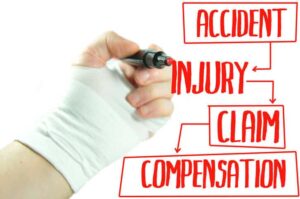Personal injury compensation is the term used for the amount of money awarded to a plaintiff in an injury lawsuit. When a person suffers an injury due to another’s negligence, a monetary award is the only practical way of making the victim whole as much as possible. No amount of money can make up for the trauma or loss of physical ability or a loved one. It can cover material losses, however, including medical costs, damaged or destroyed property, and lost income.
Also known as “damages,” personal injury compensation is a legal principle dating back to Anglo-Saxon England. 1200 years ago, an injured party would bring a complaint against the person responsible before an assembly, or folc gemot. The assembly would hear the case and render judgment. The person found liable for the injury or loss was required to pay a certain amount of gold or silver, known as weregild (literally, “man-price”) to the victim.
Today, personal injury compensation usually comes from a settlement before the case goes to trial, negotiated by attorneys for both sides. If the two sides fail to reach a settlement and the case winds up in court, the amount of the award is determined by the jury, subject to state law. Damages come under two major categories: compensatory and punitive.
Compensatory Damages
Compensatory damages are just that — compensation for actual expenses related to the plaintiff’s injuries. This category is further broken down into two subcategories, depending on whether or not losses can be quantified and assigned a specific amount.
Special Compensatory Damages
Special compensatory damages (sometimes shortened to “specials”) are awarded based on actual dollar amounts. They are relatively easy to determine because they are based on documented financial records, such as bills, invoices, pay stubs and tax returns. Special damages fall into two major subcategories:
- Medical expenses: any care, treatment, surgery and/or ongoing physical therapy is considered a medical expense. These also include x-rays or another type of medical imaging (i.e., a CT scan), medical tests, medications, trips to the ER, chiropractic treatment and even days spent at the hospital. Keep in mind that the insurer covering these expenses will expect reimbursement when the plaintiff’s lawsuit is successful.
- Loss of income or earning capacity: if injuries sustained in the accident prevent the victim from engaging in their usual employment or trade, s/he can be compensated for the income lost as a result. The loss may be temporary or permanent; for example, if an injury prevents someone from commuting to their job until they recover, they would be entitled to the wages or salary they miss during that period. If the injury is permanently disabling, the court could award an amount equivalent to what the victim would expect to earn for the remainder of their working lives.
Under certain circumstances, it may be possible to recover legal and court costs as well.
General Compensatory Damages
General or non-economic damages are those losses to which a dollar value cannot easily be assigned. They include:
- Pain and suffering: as physical pain cannot be quantified and measured in hard numbers, the court must rely on documentable facts such as the type and severity of the injury, anticipated recovery time, any necessary medications and whether or not the injury results in permanent disability.
- Mental anguish: also referred to as emotional or psychological distress, this is also difficult to measure. It includes PTSD, ongoing anxiety and depression. If you wind up having to take prescriptions for these conditions, the cost of those medications would be recoverable under special damages.
- Loss of consortium: this is broadly defined as loss of companionship. For example, if an accident leaves a person unable to engage in conjugal relations, their registered domestic partner could have grounds for loss of consortium. If a full-time mother dies in an accident, her surviving children would also have a claim.
Although it is difficult to document and measure non-economic damages, having records of the victim’s daily experiences can help the case.
It also bears mentioning that many states have caps on non-economic damages. For example, Massachusetts places a limit of $500,000 in medical malpractice lawsuits, unless the plaintiff suffers a permanent, disabling or disfiguring injury as a result.
Punitive Damages
Punitive damages (also known as “exemplary damages”) are exactly what they sound like. These are intended to punish the defendant for wrongdoing outside the criminal justice system, usually when malice or intent is involved. (Intent can also be grounds for criminal charges, but those would be separate from a tort case.)Punitive damages are also awarded when the defendant’s negligence is deemed exceptionally egregious. In this situation, it is called “gross negligence.” This means the defendant acted with blatant disregard for the safety and welfare of the plaintiff. An example might be someone who takes their car on the road, knowing the brakes are failing. Another could be a person who operates a dangerous piece of equipment around others and ignores all safety protocols.
How Punitive Damages are Determined
Punitive damages are determined by the court, so if parties to an injury lawsuit reach a settlement before the case goes to trial, there are no punitive damages. In fact, when a defendant agrees to a settlement, they usually do so with the understanding that they are under no obligation to admit any liability.
That said, a small percentage of personal injury cases do wind up in court. In the matter of punitive damages, the jury can theoretically impose any amount they feel is appropriate. However, a number of states have placed statutory caps on punitive awards. In most of these jurisdictions, this cap is equivalent to four times the amount of compensatory damages. So, if compensatory damages come to $150,000, the plaintiff would receive a maximum of $600,000 in punitive damages.
Massachusetts does not have such caps. However, a Bay State plaintiff can receive punitive damages in only two situations. One of these is a wrongful death case in which the person’s demise was due to gross negligence or wanton disregard. The other is an employment discrimination lawsuit. An example of the former would be a manufacturer who knowingly produced and distributed a product that posed a danger to certain consumers, as was the case with Ford Motors and the Pinto with its exploding gasoline tank a few decades back. An illustration of the latter is found in Haddad v. Wal-Mart Stores. The plaintiff was awarded compensatory damages of $972,000 and punitive damages of $1 million when it was found that the defendant had fired her on a pretext.
Getting Legal Counsel
Even if an injury victim has some legal background, representing yourself in an injury lawsuit is unwise. Aside from the financial burdens, injury cases can be extremely emotional, which can cloud judgment. The team at Jason Stone Injury Lawyers brings not only skill and experience but objectivity to injury cases.
If you have been hesitant to make that call because you are concerned about the expense, you should be aware that Jason Stone Injury Lawyers offers a free initial consultation and case evaluation. Under our Stone Cold Guarantee, our clients pay nothing upfront; we get paid only after we win your case. Call today; “There’s No Obligation, Just Information®.”
Not Trusting What You’re Being Told?
Better Phone Stone
800-577-5188
 START MY NO OBLIGATION CONSULTATION
START MY NO OBLIGATION CONSULTATION











